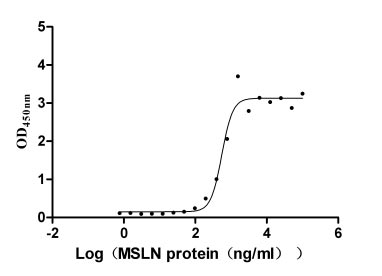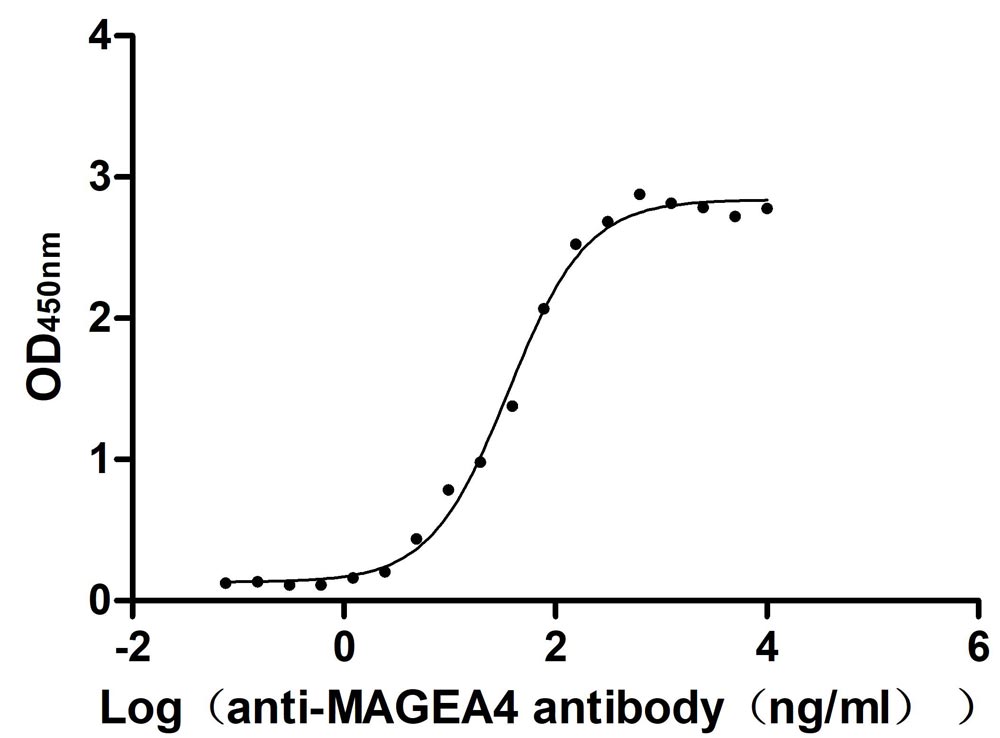Recombinant Human Nuclear autoantigenic sperm protein (NASP)
-
货号:CSB-YP015462HU
-
规格:
-
来源:Yeast
-
其他:
-
货号:CSB-EP015462HU
-
规格:
-
来源:E.coli
-
其他:
-
货号:CSB-EP015462HU-B
-
规格:
-
来源:E.coli
-
共轭:Avi-tag Biotinylated
E. coli biotin ligase (BirA) is highly specific in covalently attaching biotin to the 15 amino acid AviTag peptide. This recombinant protein was biotinylated in vivo by AviTag-BirA technology, which method is BriA catalyzes amide linkage between the biotin and the specific lysine of the AviTag.
-
其他:
-
货号:CSB-BP015462HU
-
规格:
-
来源:Baculovirus
-
其他:
-
货号:CSB-MP015462HU
-
规格:
-
来源:Mammalian cell
-
其他:
产品详情
-
纯度:>85% (SDS-PAGE)
-
基因名:NASP
-
Uniprot No.:
-
别名:5033430J04Rik; AI131596; AI317140; D4Ertd767e; DKFZp547F162; Epcs32; FLB7527; FLJ31599; FLJ35510; MGC19722; MGC20372; MGC2297; MGC93869; NASP; NASP_HUMAN; nuclear autoantigenic sperm protein (histone binding); Nuclear autoantigenic sperm protein; PRO1999; RP23 233B9.9
-
种属:Homo sapiens (Human)
-
蛋白长度:Full Length of Mature Protein
-
表达区域:2-788
-
氨基酸序列AMESTATAA VAAELVSADK IEDVPAPSTS ADKVESLDVD SEAKKLLGLG QKHLVMGDIP AAVNAFQEAA SLLGKKYGET ANECGEAFFF YGKSLLELAR MENGVLGNAL EGVHVEEEEG EKTEDESLVE NNDNIDEEAR EELREQVYDA MGEKEEAKKT EDKSLAKPET DKEQDSEMEK GGREDMDISK SAEEPQEKVD LTLDWLTETS EEAKGGAAPE GPNEAEVTSG KPEQEVPDAE EEKSVSGTDV QEECREKGGQ EKQGEVIVSI EEKPKEVSEE QPVVTLEKQG TAVEVEAESL DPTVKPVDVG GDEPEEKVVT SENEAGKAVL EQLVGQEVPP AEESPEVTTE AAEASAVEAG SEVSEKPGQE APVLPKDGAV NGPSVVGDQT PIEPQTSIER LTETKDGSGL EEKVRAKLVP SQEETKLSVE ESEAAGDGVD TKVAQGATEK SPEDKVQIAA NEETQEREEQ MKEGEETEGS EEDDKENDKT EEMPNDSVLE NKSLQENEEE EIGNLELAWD MLDLAKIIFK RQETKEAQLY AAQAHLKLGE VSVESENYVQ AVEEFQSCLN LQEQYLEAHD RLLAETHYQL GLAYGYNSQY DEAVAQFSKS IEVIENRMAV LNEQVKEAEG SSAEYKKEIE ELKELLPEIR EKIEDAKESQ RSGNVAELAL KATLVESSTS GFTPGGGGSS VSMIASRKPT DGASSSNCVT DISHLVRKKR KPEEESPRKD DAKKAKQEPE VNGGSGDAVP SGNEVSENME EEAENQAESR AAVEGTVEAG ATVESTAC
-
蛋白标签:Tag type will be determined during the manufacturing process.
The tag type will be determined during production process. If you have specified tag type, please tell us and we will develop the specified tag preferentially. -
产品提供形式:Lyophilized powder
Note: We will preferentially ship the format that we have in stock, however, if you have any special requirement for the format, please remark your requirement when placing the order, we will prepare according to your demand. -
复溶:We recommend that this vial be briefly centrifuged prior to opening to bring the contents to the bottom. Please reconstitute protein in deionized sterile water to a concentration of 0.1-1.0 mg/mL.We recommend to add 5-50% of glycerol (final concentration) and aliquot for long-term storage at -20℃/-80℃. Our default final concentration of glycerol is 50%. Customers could use it as reference.
-
储存条件:Store at -20°C/-80°C upon receipt, aliquoting is necessary for mutiple use. Avoid repeated freeze-thaw cycles.
-
保质期:The shelf life is related to many factors, storage state, buffer ingredients, storage temperature and the stability of the protein itself.
Generally, the shelf life of liquid form is 6 months at -20°C/-80°C. The shelf life of lyophilized form is 12 months at -20°C/-80°C. -
货期:Delivery time may differ from different purchasing way or location, please kindly consult your local distributors for specific delivery time.Note: All of our proteins are default shipped with normal blue ice packs, if you request to ship with dry ice, please communicate with us in advance and extra fees will be charged.
-
注意事项:Repeated freezing and thawing is not recommended. Store working aliquots at 4°C for up to one week.
-
Datasheet :Please contact us to get it.
相关产品
靶点详情
-
功能:Required for DNA replication, normal cell cycle progression and cell proliferation. Forms a cytoplasmic complex with HSP90 and H1 linker histones and stimulates HSP90 ATPase activity. NASP and H1 histone are subsequently released from the complex and translocate to the nucleus where the histone is released for binding to DNA.
-
基因功能参考文献:
- NASP is targeted by miR-29c in gastric cancer cells. miR-29c can decrease NASP expression and the effects observed following miR-29c overexpression are partially due to NASP depletion. PMID: 28173777
- findings reveal a new mode of interaction between a TPR repeat domain of histone chaperone sNASP and an evolutionarily conserved peptide motif found in canonical H3 and in all histone H3 variants PMID: 26673727
- Our research demonstrates that knockdown of tNASP effectively inhibits the proliferation and causes G1 phase arrest through ERK/MAPK signal pathway. PMID: 25669170
- These results provide evidence that tNASP is ubiquitously produced in various types of human tissues and promotes in vitro nucleosome assembly with H3 variant specificity. PMID: 25615412
- NASP family Proteins are highly conserved throughout the eukaryotes and posses four TPR motifs. It was likely present in the last common ancestor of eukaryotes possibly representing an important innovation regarding H3/H4 transport mechanism. Different TPR motifs in NASP have evolved at different rates with TPR1/4 evolving faster than TPR2/3. PMID: 24951090
- Studies indicate that histone chalerones nucleoplasmin (NPM2/NPM3) preferentially associated with histones H2A-H2B in the egg and the nuclear autoantigenic sperm protein (NASP) families. PMID: 22968912
- an increase of miR-29a, and hence decrease of Nasp, may contribute to inhibit cell proliferation during postnatal organ development. PMID: 22194605
- sNASP interacts with linker and core histones through distinct structural domains. PMID: 21965532
- The insights into NASP function and the existence of a tunable reservoir in mammalian cells demonstrate that contingency is integrated into the histone supply chain to respond to unexpected changes in demand. PMID: 22195965
- tNASP is critical for the survival of prostate cancer cells; targeting tNASP expression can lead to a new approach for prostate cancer treatment. PMID: 21496299
- NASP and RCAS1 proteins were more frequently expressed in ovarian cancer tissues than with normal ovarian tissue and serous cystadenomas and MRE11 was less frequently expressed PMID: 20164540
- A deletion analysis of sNASP revealed that the central region, amino acid residues 26-325, of sNASP is responsible for nucleosome assembly in vitro. PMID: 20167597
- NASP and the linker histones are key players in the assembly of chromatin after DNA replication PMID: 16728391
- NASP forms distinct, high specificity complexes with histones H3 and H4. PMID: 18782834
- NASP belongs to a network of genes and gene functions that are critical for cell survival PMID: 19439102
显示更多
收起更多
-
亚细胞定位:Cytoplasm. Nucleus.
-
蛋白家族:NASP family
-
组织特异性:Isoform 1 is testis- and sperm-specific.
-
数据库链接:
HGNC: 7644
OMIM: 603185
KEGG: hsa:4678
STRING: 9606.ENSP00000255120
UniGene: Hs.319334
Most popular with customers
-
Recombinant Human Mucin-16 (MUC16), partial (Active)
Express system: Mammalian cell
Species: Homo sapiens (Human)
-
Recombinant Human Melanoma-associated antigen 4 (MAGEA4) (Active)
Express system: Mammalian cell
Species: Homo sapiens (Human)
-
Recombinant Human G-protein coupled receptor family C group 5 member D (GPRC5D)-VLPs (Active)
Express system: Mammalian cell
Species: Homo sapiens (Human)
-
Recombinant Human Claudin-6 (CLDN6)-VLPs, Fluorescent (Active)
Express system: Mammalian cell
Species: Homo sapiens (Human)
-
Recombinant Human Carcinoembryonic antigen-related cell adhesion molecule 6 (CEACAM6) (Active)
Express system: Mammalian cell
Species: Homo sapiens (Human)
-
Recombinant Human Alkaline phosphatase, germ cell type (ALPG) (Active)
Express system: Mammalian cell
Species: Homo sapiens (Human)
-
Recombinant Human C-C chemokine receptor type 9 (CCR9)-VLPs (Active)
Express system: Mammalian cell
Species: Homo sapiens (Human)
-
Express system: Mammalian cell
Species: Macaca mulatta (Rhesus macaque)





f4-AC1.jpg)














